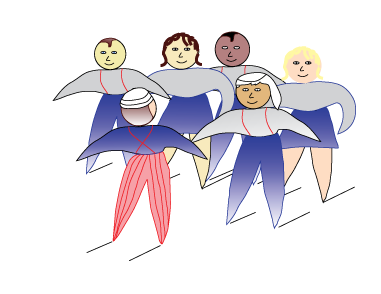November 2009 - The FoCuSeD™ Facilitator eNewsletter

Different Cultures and the Facilitator | Gary Rush Facilitation
Lately I’ve had the opportunity to see and work with people from multiple cultures. What I’ve seen has given me an appreciation for and thoughts about behaviors, customs, characteristics, and what this means for Facilitators.
In looking at people across five continents, the only real characteristic that separates us is the economic status, but what differentiates us – our customs and behaviors – is what makes us interesting.
What Differentiates Us?
As Facilitators, we have to take into account the characteristics that differentiate us:
- Our Behaviors – how we act or conduct ourselves.
- Our customs, dress, and food, amongst others.
- Our work tendencies – how frenzied and driven we are or are not in our work.
- Our religious practices – not so much what we believe, but the methods in which we practice.
- Our relations – how formally we address each other; whether we ask about family before business; whether we hold our extended family close or distant.
These differentiating characteristics are what make us interesting. It would be our misfortune if we all became homogenized. The differences enrich us and give us color and complexity. There should be no judgment – one difference is not better than another. They are just different.
What does this mean to the Facilitator?
The competencies of a Facilitator are the same regardless of culture. What does change is how a Facilitator works with the participants and client and how the participants and client perceive the Facilitator. There are no “right” ways to facilitate.
In working with the participants and clients, Facilitators need to understand the cultural norms. Each culture is different. Take the time to prepare.
- Do you shake hands, touch noses, kiss the cheeks, or bow when greeting participants?
- How you address people – formally or informally. Do you use first names or address participants as, “Mr.” or “Miss”?
- What type of attire is acceptable?
- The issue of “context” – do the participants relate to you if you ask about their family first or do they just want to get to work? In some cultures, if you skip asking about the family, you will be perceived as cold and uncaring. In others, you may be perceived as slowing the work process.
- When participants “agree”, what does that really mean? In some cultures it means that they really agree. In others, it means that they agree to think about it. In others still, it means that they are simply validating the opinion of the senior person.
- How much can you joke? Some cultures accept certain humor. Using humor that doesn’t work with a particular culture will backlash.
- Watch slang and word usage. Language is not universal – even with the same base language (e.g., English, Spanish, French, Arabic). All have variations.
- What are the work hours? Different cultures work at different times – both work-hours and different days of the week. They won’t change their practices to meet the schedule of the Facilitator.
How the participants and clients perceive the Facilitator, understand:
- Different cultures perceive male and female Facilitators differently. You cannot change their perception. Their perception changes as you deal with them and through effectively facilitating. Be aware of its affect on what you ask them to do. Your attitude will affect how successful you are.
- Different cultures view the age of the Facilitator as important. You are respected if you are a “grey-haired” Facilitator.
- How do you carry yourself? Different cultures – especially western corporate culture – being strong and aggressive can be effective – but in dealing with a community group in a developing area, you may alienate the participants.
Facilitators need to be flexible when facilitating the different cultures. Guidelines about our own behavior need to be taken in the context of our clients. Some examples:
- “You should always stand.” It is not appropriate for every situation. I have watched Facilitators who deal with community groups in developing areas where the Facilitator sat on the floor. It worked because the community group viewed the Facilitator as helping, not driving.
- “Make eye contact with the participants.”Again, not appropriate for every situation. Some cultures feel intimidated or threatened when make eye contact.
Conclusion
It’s great to see that we are not the same – life is more interesting as a result. We need to be aware and sensitive to people from multiple cultures. It is wrong to think that they will adjust to us. As Facilitators, we help because we learn to be effective collaborators. We learn to accept and respect others. We learn to empower people to make effective decisions, but we need to expand our frame of reference. We need to prepare to embrace the characteristics that differentiate us. Neutrality and ethics are part of the Facilitator’s code, part of our competencies, and must guide us in working with multiple cultures. ![]()

